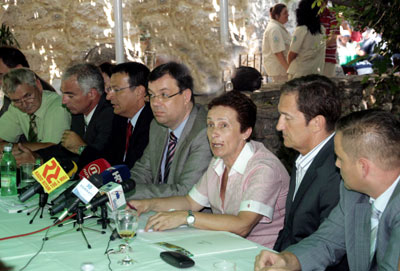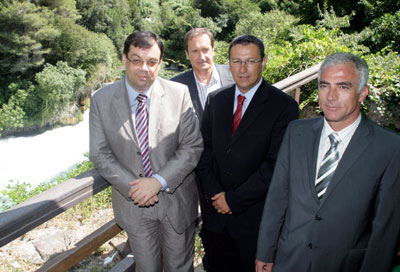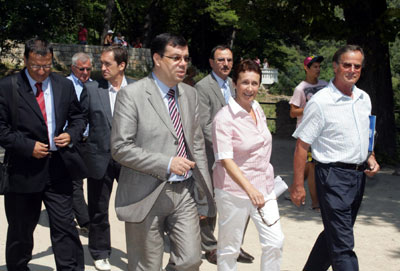- Published: 07.08.2009.
Tourism minister says arrivals down 5%, overnight stays down 3%
Croatian Tourism Minister Damir Bajs said on Friday that in the first seven months of this year tourist arrivals and overnight stays had dropped five and three percent respectively, which he said was not bad in comparison to other Mediterranean countries. In the first seven months of this year, 5.3 million tourists vacationed on the Croatian Adriatic coast, a 5% drop from the same period of last year. They generated 29.7 million overnight stays, a 3% drop from last year, Bajs said at a news conference in the national park Krka. In July, Croatia saw 2.5 million tourist arrivals, a 3% decrease in relation to July 2008. Overnight stays also dropped by three percent to 17.7 million.
Croatian Tourism Minister Damir Bajs said on Friday that in the first seven months of this year tourist arrivals and overnight stays had dropped five and three percent respectively, which he said was not bad in comparison to other Mediterranean countries.
In the first seven months of this year, 5.3 million tourists vacationed on the Croatian Adriatic coast, a 5% drop from the same period of last year. They generated 29.7 million overnight stays, a 3% drop from last year, Bajs said at a news conference in the national park Krka.

In July, Croatia saw 2.5 million tourist arrivals, a 3% decrease in relation to July 2008. Overnight stays also dropped by three percent to 17.7 million.
The decrease in tourist turnover is evident, but it is acceptable, especially when compared to other Mediterranean countries, Bajs said at the news conference held after a meeting with Croatian Tourism Board director Niko Bulic and heads of tourism boards from the country's coastal counties.

The minister went on to say that Croatia's drop in tourist turnover was smaller than that of other Mediterranean countries like Spain, France, Greece, Portugal and Malta, with the exception of Tunisia, which he said was the only Mediterranean country to see an increase in tourist arrivals.
"According to available information, the statistics for August are showing more favourable results, and August, too, will see a continuation of last-minute booking, which is the main characteristic of this season."

As for Croatia's most important tourist markets - Germany, Austria, Poland, Slovenia and Great Britain, a drop in arrivals and overnight stays was reported only in case of Slovene visitors. In the first seven months, the number of arrivals from Slovenia dropped 7%, while the number of their overnight stays went down 4% from the same period of last year.
The number of tourists from Hungary and Russia dropped the most as a direct result of the crisis, with both arrivals and overnight stays going down 20 percent.
At the same time, the number of tourist arrivals from Ukraine, Serbia, Finland, Spain, Switzerland and Bulgaria increased, Bajs said, adding that this was a result of intensified promotional activities.
The only coastal county which saw an increase in tourist turnover in the first seven months was Lika-Senj County, which reported a 3% increase in arrivals and overnight stays.
In the first seven months, Sibenik-Knin County saw the biggest drop in tourist arrivals, of 10%, while overnight stays in that county dropped by 3%.

In July, Lika-Senj County saw a 1% rise in tourist turnover, Dubrovnik-Neretva County saw a 1% increase in foreign arrivals, while Sibenik-Knin County saw a 1% increase in overnight stays generated by domestic tourists.
Zadar County saw the biggest year-on-year drop in arrivals in July, of 9%, while overnight stays dropped by two percent. (Hina)
In the first seven months of this year, 5.3 million tourists vacationed on the Croatian Adriatic coast, a 5% drop from the same period of last year. They generated 29.7 million overnight stays, a 3% drop from last year, Bajs said at a news conference in the national park Krka.

In July, Croatia saw 2.5 million tourist arrivals, a 3% decrease in relation to July 2008. Overnight stays also dropped by three percent to 17.7 million.
The decrease in tourist turnover is evident, but it is acceptable, especially when compared to other Mediterranean countries, Bajs said at the news conference held after a meeting with Croatian Tourism Board director Niko Bulic and heads of tourism boards from the country's coastal counties.

The minister went on to say that Croatia's drop in tourist turnover was smaller than that of other Mediterranean countries like Spain, France, Greece, Portugal and Malta, with the exception of Tunisia, which he said was the only Mediterranean country to see an increase in tourist arrivals.
"According to available information, the statistics for August are showing more favourable results, and August, too, will see a continuation of last-minute booking, which is the main characteristic of this season."

As for Croatia's most important tourist markets - Germany, Austria, Poland, Slovenia and Great Britain, a drop in arrivals and overnight stays was reported only in case of Slovene visitors. In the first seven months, the number of arrivals from Slovenia dropped 7%, while the number of their overnight stays went down 4% from the same period of last year.
The number of tourists from Hungary and Russia dropped the most as a direct result of the crisis, with both arrivals and overnight stays going down 20 percent.
At the same time, the number of tourist arrivals from Ukraine, Serbia, Finland, Spain, Switzerland and Bulgaria increased, Bajs said, adding that this was a result of intensified promotional activities.
The only coastal county which saw an increase in tourist turnover in the first seven months was Lika-Senj County, which reported a 3% increase in arrivals and overnight stays.
In the first seven months, Sibenik-Knin County saw the biggest drop in tourist arrivals, of 10%, while overnight stays in that county dropped by 3%.

In July, Lika-Senj County saw a 1% rise in tourist turnover, Dubrovnik-Neretva County saw a 1% increase in foreign arrivals, while Sibenik-Knin County saw a 1% increase in overnight stays generated by domestic tourists.
Zadar County saw the biggest year-on-year drop in arrivals in July, of 9%, while overnight stays dropped by two percent. (Hina)
